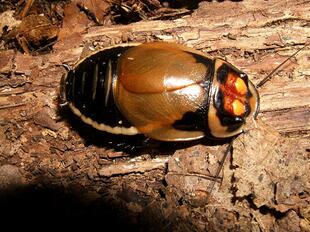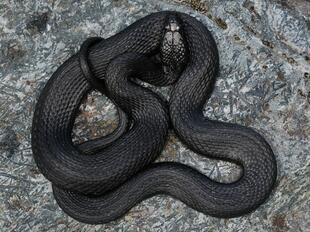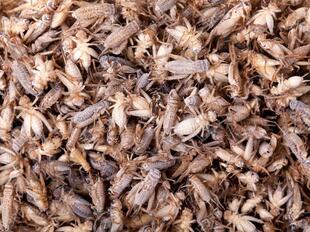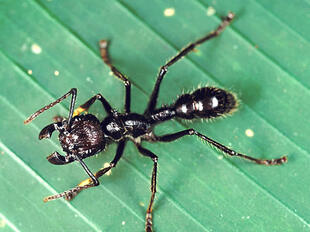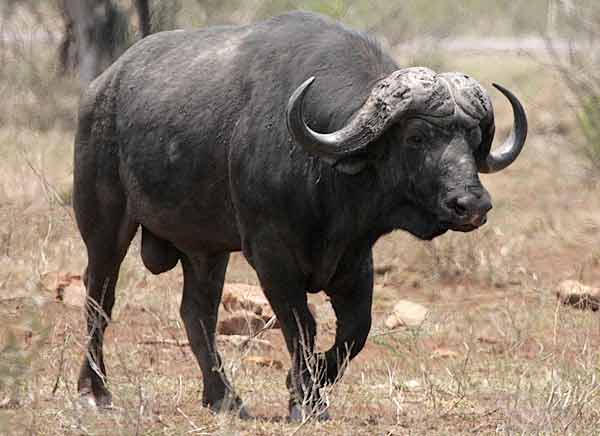
African buffalo(Syncerus caffer)
Phylum —chordata
Class — mammalia
Order — artiodactyla
Family — bovidae
Genus – syncerus
Appearance
The African buffalo is a very robust species. Its shoulder height can range from 1.0 to 1.7 m (3.3 to 5.6 ft) and its head-and-body length can range from 1.7 to 3.4 m (5.6 to 11.2 ft). Compared with other large bovids, it has a long but stocky body and short but thickset legs, resulting in a relatively short standing height. The tail can range from 70 to 110 cm (28 to 43 in) long. The front hooves of the buffalo are wider than the rear, which is associated with the need to support the weight of the front part of the body, which is heavier and more powerful than the back.
A characteristic feature of the horns of adult male African buffalo (Southern and Eastern populations) is that the bases come very close together, forming a shield referred to as a "boss". From the base, the horns diverge downwards, then smoothly curve upwards and outwards and in some cases inwards and or backwards. In large bulls, the distance between the ends of the horns can reach upwards of one meter. The horns form fully when the animal reaches the age of five or six years but the bosses do not become "hard" till 8 to 9 years old. In cows, the horns are, on average, 10–20% smaller, and they do not have a boss.
Habitat
African buffalo occur in Sub-Saharan Africa. They live in swamps and floodplains, as well as mopane grasslands, and the forests of the major mountains of Africa.
Behavior
African buffalo may be active throughout the day and night. They are social and live in herds which consist of related females, and their offspring, in an almost linear dominance hierarchy. During the dry season, males leave the herd and form bachelor groups. During the wet season, the younger bulls rejoin a herd to mate with the females. They stay with them throughout the season to protect the calves.
African buffalo make various vocalizations. They emit low-pitched calls to signal the herd to move. To signal to the herd to change direction, leaders emit "gritty", "creaking gate" sounds. When moving to drinking places, some individuals make long "maaa" calls up to 20 times a minute. When being aggressive, they make explosive grunts that may last long or turn into a rumbling growl. Cows produce croaking calls when looking for their calves. Calves make a similar call of a higher pitch when in distress. When threatened by predators, they make drawn-out "waaaa" calls. When grazing, they make various sounds, such as brief bellows, grunts, honks, and croaks.
Diet
African buffalo have a strictly herbivorous diet. They feed on a wide variety of grasses, sedges, leaves, and other plants.
Reproduction
African buffalo are polygynandrous meaning that both males and females mate with multiple partners. They mate and give birth only during the rainy seasons. Birth peak takes place early in the season, while mating peaks later. A dominant bull in the herd/subherd closely guards a cow that is ready to mate and keeps other bulls at bay. This is difficult, as cows are quite evasive and attract many males to the scene.
Cows usually reproduce every two years. They give birth to a single calf after a gestation period of 11.5 months. Newborn calves remain hidden in vegetation for the first few weeks while being nursed occasionally by the mother before joining the main herd. Older calves are held in the center of the herd for safety. Calves are typically weaned by 9 or 10 months. The maternal bond between mother and her offspring lasts longer than in most bovids. However, when a new calf is born, the bonding ends and the mother keeps her previous offspring at bay with horn jabs. Nevertheless, the yearling follows its mother for another year or so. Males leave their mothers when they are two years old and join the bachelor groups. African buffalo calves usually become independent between one and two years of age. Young females start breeding at 5 years of age. Males become reproductively mature when they are 4 to 6 years old.
African buffalo can live up to 22 years in the wild and have been recorded living 29.5 years in captivity.
In captivity
African buffalo need large, secure enclosures. You don’t want a very large, angry, and confused animal running through a fence and greeting guests up close! Their enclosures must also be quite large because they are social, and live in groups.
Herds of these animals need plenty of space to graze on grass. Keepers provide hay to supplement their diet, and a number of vitamins and nutrients at the recommendation of their veterinarians.
Because buffalo are such powerful animals, any interaction between them and keepers occurs in protected contact, where there is a physical barrier between the keeper and the animal.
 Russian
Russian
 English
English




















